Magazine
Design incorporates objects, people,
ideas based on the small pleasures of everyday life.
Meet your Beautiful design world with the DDP Design Fair.
-
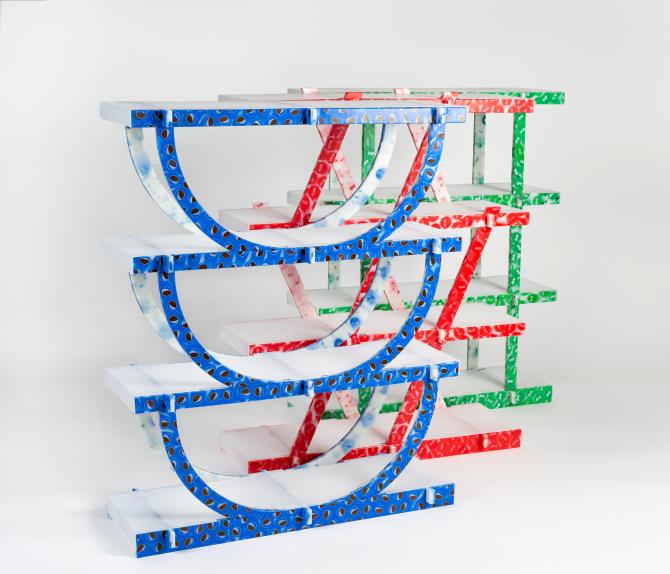
FURNITURE
COLLABORATION/Would you love+SOHN DAE YEOLThe "SODA COLLECTION" is based on the structural potentials of recycled materials, where we designed three types of shelves by repeatedly expanding and combining modular elements—arches, trusses, and beams.To further emphasize sustainability, we incorporated discarded plastic bottle caps from beverage companies, recognized as significant contributors to plastic waste. By utilizing their unique colors and patterns, the design seeks to engage the public and foster awareness about environmental issues and the importance of plastic recycling in an accessible and visually compelling way.MAKER Would you loveWe crush and thermoform waste plastic to create plastic sheets. The pattern created for this project features bottle caps on both sides of the sheet, with the spaces in between filled with mixed bottle cap chips. While previous projects involved crushing the bottle caps to create sheets, this time, we intentionally left the bottle caps intact to preserve their shape within the pattern. Each 950x950mm sheet requires between 1,000 and 1,300 bottle caps. Through this collaboration, we hope that the process of transforming waste plastic into furniture will become more intuitive for consumers.DESIGNER SOHN DAE YEOLInitially, I was concerned about potential communication issues, given that the manufacturer was a foreigner. However, this concern proved unnecessary as she communicated fluently in Korean. Our project aimed to expand the application of recycled plastic, moving beyond small accessories to incorporate furniture and larger-scale installations. By creating a modular assembly system with plastic sheets, we demonstrated how recycled materials can be effectively used for structural purposes. The 'SODA COLLECTION' is far from a one-off project—it will continue to evolve, with future plans to include chairs and space designs, while maintaining a focus on sustainable, long-term collaboration with the manufacturer.
2024-12-0258 -
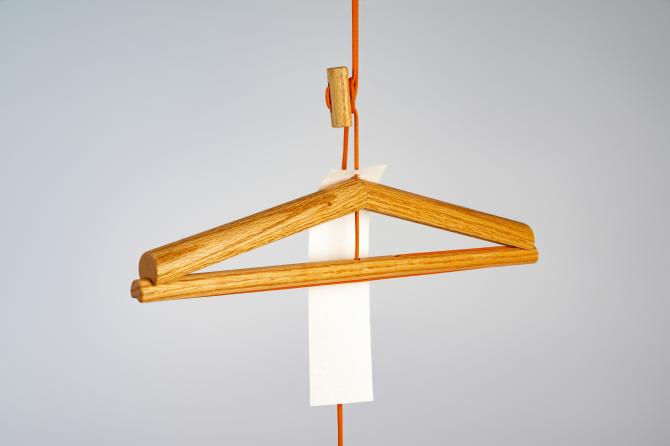
Daily supplies
컬래버레이션/Wood Studio WOOM+UUJP STUDIOCon is a unique design hanger that offers a fresh take on the traditional household hanger. Moving away from the conventional triangular hook design, it combines sturdy wood with flexible cords, creating a distinctive piece that doubles as a decorative object in everyday spaces. Divided into two sections, the upper part is designed to hang tops by hooking them in the opposite direction, while the lower part can be used for hanging pants or accessories like hats, scarves, and belts on either end.MAKER Wood Studio WOOMI wanted to expand beyond the traditional joinery techniques I had been using. By collaborating with the designer, we were able to create a product that truly brought out the intricate details. The new concept for the hanger design was intriguing and sparked a lot of questions on how to produce it. Fortunately, the smooth communication with the designer helped us navigate any challenges. In particular, the discussions around the processing details were highly productive, resulting in a fantastic final product.As someone who primarily works with wood, the designer's attention to packaging provided me with a valuable opportunity to enhance the finishing details. The design was quite intricate, with many curves, angles, and grooves. It was a great opportunity to create a custom jig that helped streamline the process and improve efficiency. DESIGNER UUJP STUDIOI was truly impressed by the manufacturer’s professional understanding of woodworking, which led me to propose the collaboration. After the initial pairing, I visited their workshop to discuss wood properties, finishing techniques, and various production methods. We decided to move forward with the hanger, as it was a great fit for mass production. Together, we fine-tuned the production process and also considered packaging. The manufacturer’s expertise allowed us to smoothly exchange feedback and improve the production process. Overall, it was a fantastic experience working in sync with the manufacturer and seeing the collaboration come to life.
2024-12-0254 -
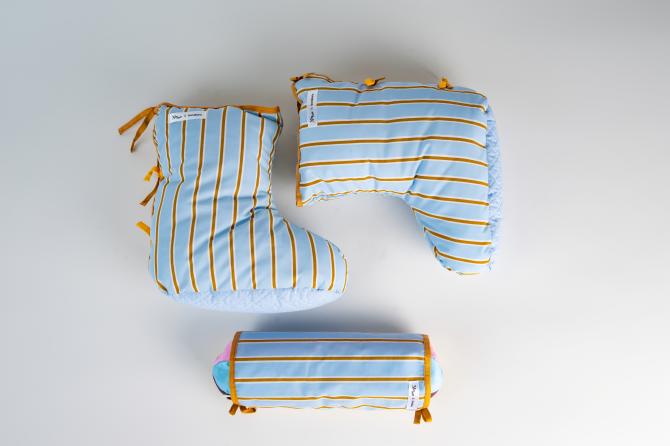
Daily supplies
COLLABORATION/ WAKAWAKA+FUNDERKAMMERBy reinterpreting items steeped in Korea's long history, we have developed a product set focused on providing ultimate relaxation at home.The cervical pillow is designed in the shape of a pentagonal column, inspired by the traditional Korean colors of Obangsaek (five colors) and Ogansaek (a related palette derived from Obangsaek). It incorporates red, blue, green, yellow, and purple.The pillow is crafted to align with the natural curvature of the neck, promoting restful sleep and effective cervical spine alignment. The sleep boots are inspired by the traditional Korean "beoseon" (socks) and "mokhwa-shin" (slippers), designed as a set with the cervical pillow.MAKER WAKAWAKAThis project allowed us to expandbeyond the limited category of pillows and explore the broader domain of home and relaxation. Collaborating with a designer experienced in garment production brought fresh perspectives and a sharp eye for detail, enabling us, as manufacturers, to adopt a more consumer oriented approach. With hands-on manufacturing experience through her sewing skills, the designer was able to create designs that were mindful of the production process. Although WAKAWAKA has traditionally focused on cervical pillows, this partnership has opened up new opportunities for diversifying the product line.DESIGNER FUNDERKAMMERThroughout the process of designing the product inspired by tradition, we maintained frequent communication both online and offline, exchanging ideas and fine-tuning the design. The collaborative brainstorming sessions were much more enriching than working alone, and we are truly satisfied with the resulting product.
2024-12-0248 -
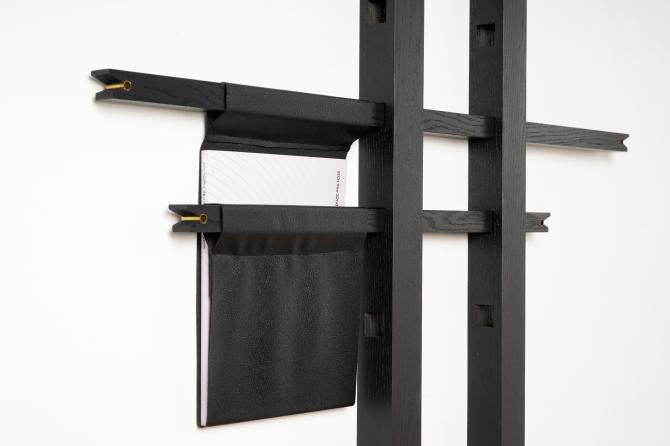
FURNITURE
COLLABORATION/AlldayOn+SOT"Doung" is a design inspired by the pillar structure of traditional Hanok (Korean houses), expressing the proportional beauty of Hanok architecture through simple vertical and horizontal lines. True to its name, which suggests something that both appears to do and not do something, Doung functions as a clothes hanger while also serving as a decorative object that enhances the ambiance when not in use.Doung features adjustable horizontal components that can be moved and arranged according to the user's preferences, with the flexibility to add additional pieces as needed. Users can select parts such as hooks or storage racks to meet their specific needs, and a guideline is provided for easy installation, allowing for simple attachment to the wall.Doung is a product that modernizes the beauty of traditional Hanok, transforming a space into a refined environment. It seamlessly blends Korean traditional aesthetics with contemporary practicality, allowing you to harmoniously experience both.MAKER AlldayOnThe team worked hard to stay true to the original concept while overcoming challenges during production. By carefully addressing issues and incorporating feedback, we were able to deliver a high-quality final product. This collaborative experience would serve as a meaningful reference for future projects.DESIGNER SOTExchanging feedback throughout the design and production process provided valuable insights from multiple perspectives. By prioritizing consumer needs, we meticulously refined the shape, structure, and finishing details, experimenting with various approaches to achieve a high-quality final product. As a designer, production has always been a challenge for me, but this collaboration offered a meaningful opportunity for growth and learning.
2024-12-0246 -
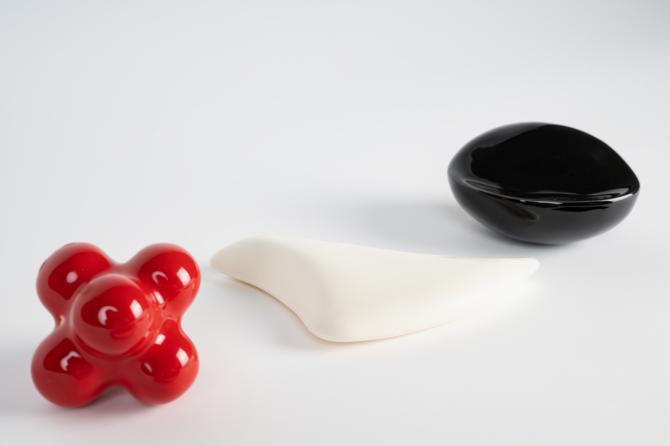
Daily supplies
COLLABORATION/Oikeiosis Museum+Hye Min KimThe "Rotund Ceramic Guasha" originated from the point of contact with the body. Three distinct shapes were created: one for the face and neck, one for the arms and collarbones, and a larger one to soothe the lower back and pelvic lines. Since a guasha is an object that comes into contact with the body, its shape must feature natural curves to ensure it feels soft and stable on any part of the body. To achieve this, all lines are curved and inflated, providing an ergonomic shape that enhances comfort. Even when not in use, the product is designed to seamlessly blend into any space, yet remain an aesthetically pleasing object. As an item that interacts with the body, much attention was given to the grip and ergonomic shape, resulting in a voluminous, aesthetically pleasing form.MAKER Oikeiosis MuseumThe development of the guasha product went smoothly because I could easily share my needs from a user perspective. We exchanged a lot of feedback, and as a product designer, I worked on connecting those needs to the grip and ergonomic form, refining it into a functional, user-friendly product. This collaborative process of improving the product was incredibly rewarding.I had so many conversations with the designer about guashas—its uses, forms, and features—and being able to directly influence everything from the ergonomic design to the final product made the experience even more meaningful. Ceramic production is a lengthy and challenging process. There wasn’t a single step that felt easy, but it was a great learning experience, especially in exploring new manufacturing methods.DESIGNER Hye Min KimGuashas are crafted from various materials, including wood, ceramics, and cow horn. Of these options, the ceramic guasha stood out as particularly elegant. I deeply appreciate designer Na-yeon Kim’s ability to successfully bring my envisioned shape to life. The process involved its fair share of trial and error, but effective communication allowed us to achieve the desired result.Participating as a designer in the ceramic production process was a great opportunity to observe the intricate details and nuances of production. I found the merging of design and production processes, with all the unique challenges, to be fascinating. I’ve always wanted to use a more aesthetically pleasing guasha, and this product development has finally fulfilled that desire.
2024-12-0243 -
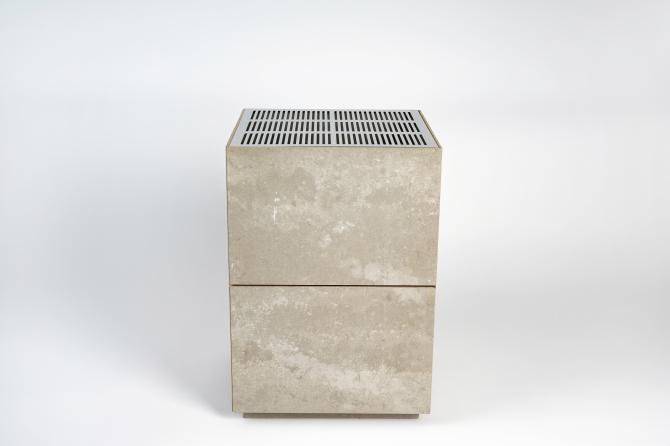
FURNITURE
COLLABORATION/nwd+SEONG HO JUNCON CREATE is a creative furniture brand designed to align with modern lifestyles. The name CON encompasses the ideas of "Construct" and "Connect," while CREATE emphasizes individual imagination and creativity.The Cement Panel Drawer is a piece of furniture that emphasizes minimalistic aesthetics and practicality. Crafted from durable, non-toxic cement, it is designed for lasting durability and offers the flexibility to be easily customized and adapted to the user’s specific needs and tastes.The product consists of a single drawer and a storage compartment, making it ideal for effectively storing various items with minimal risk of deformation or damage even after extended use. Beyond serving as simple storage, this product offers the flexibility to create a variety of designs by allowing users to replace the top surface according to their preferences.The top surface is available in a selection of materials, including steel, glass, and acrylic, enabling personal customization. Additionally, the upper storage compartment can be fitted with lighting options, enhancing the ambiance of the space.MAKER nwdWe believed the designer’s humanistic approach would be a great asset to the product development process. However, during the early stages, we faced challenges due to differences in communication styles. Additionally, balancing technical precision with philosophical elements required time and careful coordination. Despite these challenges, we respected each other’s strengths and made a concerted effort to achieve the best possible result.DESIGNER SEONG HO JUNFrom a design perspective, we sought to harness the raw yet refined qualities of cement and steel to create furniture reminiscent of urban architecture. In an era where furniture is crafted from diverse materials, we wanted to experiment with cement—an unconventional choice—to establish a distinctive aesthetic unique to our product.In terms of functionality, we focused on offering users the flexibility to customize the furniture according to their needs, allowing them to create different styles and atmospheres. The development process was highly valuable, as we exchanged practical ideas and know-how from the perspective of the manufacturers. By leveraging each of our expertise, we were able to create a design that strikes a balance between practicality and aesthetics.Through this collaboration, we had the opportunity to see our designs come to life as actual products, offering valuable insights. It also provided a moment to reflect on the true essence of design and allowed us to achieve our goal of creating innovative furniture that reflects our vision. I believe this project successfully gave birth to a new piece of furniture that embodies both function and creativity.
2024-12-0245 -
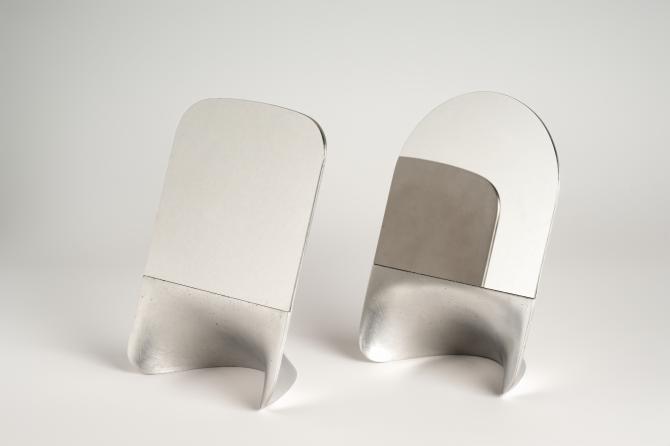
Daily supplies
COLLABORATION/EKA CRAFT+contourstudioThe Warp Mirror is designed by twisting the lower part of a two-dimensional shape, transforming it into a self-standing three-dimensional form. Its curved surface provides both stability and aesthetic appeal. The mirror is mounted on top of the aluminum cast body, with the color carefully matched to create a seamless, unified look. Available in two designs—circular and rounded square—it serves as an elegant addition to a makeup table or desk, making it a luxurious everyday accessory.MAKER EKA CRAFTParticipating in the planning and manufacturing of a new item allowed me to learn how the designer’s aesthetic sense is applied to functional objects, and the collaboration resulted in excellent outcomes. By combining the designer's creative ideas with my technical expertise, we were able to create a high quality product. Working together during the design process allowed us to quickly identify and address any potential issues, saving both time and costs.It also provided an opportunity to explore the development of different product lines, such as a mirror—a product type I hadn’t worked on before. Through this collaboration, we were able to anticipate and resolve potential challenges in both the design and manufacturing phases, reducing costs and development time. By creating a product that integrates both design and functionality, we expanded the potential of metal craftsmanship.DESIGNER contourstudioFrom the early stages of planning, we shared various ideas and concepts with the manufacturing company, which resulted in a fresh and innovative product that could not have been achieved alone. Additionally, throughout the process of turning the design into a physical product, we received a lot of input, which greatly contributed to refining and enhancing the design. This experience was enjoyable, as it allowed me to bring a new perspective to the project, and sharing expertise from design to the final product resulted in a highly refined outcome. The collaboration between EKA CRAFT and Contourstudio was a perfect match, especially in terms of balancing the design and modification processes during production. This collaboration, in which we used aluminum casting to create the product, was a significant experience. In the future, we aim to create products using a variety of materials and designs, eventually expanding into product sales.
2024-12-0258 -
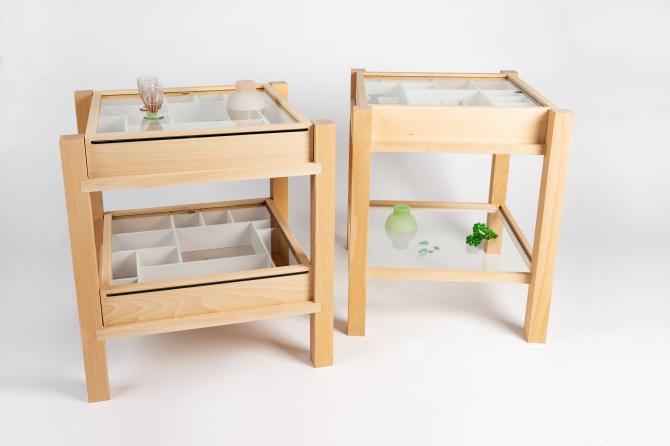
FURNITURE
COLLABORATION/AGO STUDIO+BeenzeeneeStorage ABC invites you to fill its various-sized compartments with your own time, memories, and meaning. The storage unit, designed in the form of a picture frame with squares of varying sizes, is fully customizable to fit the user's preferences and needs. It can function as a side table, shelf, frame, storage unit, or simply as an objet d'art. Made from light-colored beech wood, the storage unit features sliding doors with glass inserts, allowing you to securely store your items while maintaining visibility.MAKER AGO STUDIOAfter two years of collaboration, we were once again paired with designer Beenzeenee this year to launch a new product. I’m excited about the products we’ll create together next year. This project also gave me the opportunity to explore new structural designs that I hadn’t worked with before, while managing the brand directly. Since our goal was to produce affordable products that would be accessible to the general public, we focused on streamlining the production process and finding the right materials.DESIGNER BeenzeeneeAfter collaborating with AGO Studio for two years, I’m thrilled to have the opportunity to once again present a product that embodies both of our identities. Their invaluable support in the design and structural aspects allowed us to work through structural limitations and create something new. It was a truly enriching experience. I am eager to participate in next year's fair and look forward to unveiling the new products we will once again create with AGO Studio.
2024-12-0251







